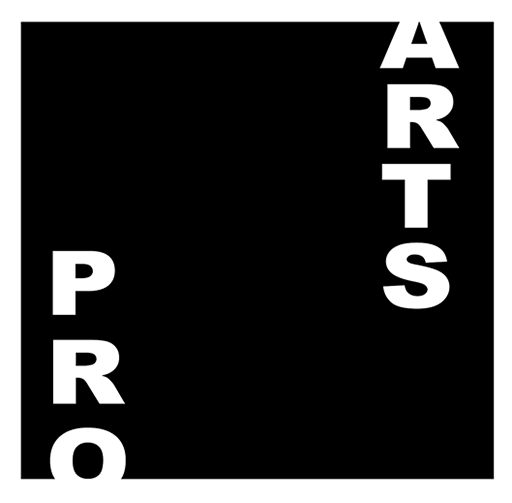Pam Cooper In Conversation with Ravan Williams
Pam Cooper’s Exhibit “Through the Window” was on display at Windows on Columbus through April 28th, 2016
Click here for more info Pam Cooper Exhibit
Growing up in Great Britain, do you feel that the cultural aspect of your childhood and upbringing, along with their educational system strongly influenced your works?
Almost certainly, but also I am of a different generation, we had a lot more freedom than the children have now. I think we do over commit and over protect our children at
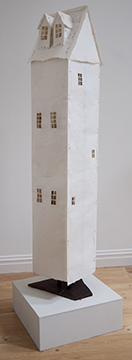
times with some good cause. During my childhood there was not the amount of information available now, not saying that bad stuff wasn’t happening but we just didn’t hear about it unlike now.
The educational system was very different, choosing specialist subjects at a much earlier age. At thirteen I was taking Biology, Physics, Chemistry and History along with all the core subjects and Liberal Arts finishing my education at twenty one with a BS. Pharmacy. It wasn’t until I was forty that I went to Pratt and obtained a BFA. I think this is why I am a mixed media artist. As a pharmacist you have to follow all the rules, in art I could do anything and I tried everything.
How did you begin your series of artwork that comprises of installations and sculptures?
I graduated from Pratt in ’94 with a BFA majoring in sculpture actually making large wooden pieces. Unfortunately I was then very sick and was unable to continue on with the large sculpture as I wasn’t physically able. During my final year I had an internship at Dieu Donne paper making studio in the city. I started to make small paper pieces and experiment with them, adding metal in the form of pins and needles which would rust along with thread and sewing pattern tissue. I like working large so the only way to do that was to attach large pieces of paper to walls along diminutive furniture, creating my own spaces in small rooms, closets, cupboards etc. The sculptures grew out of these, constructing houses out of my own abaca paper either suspended from the ceiling or floor standing.
How did your residency in the Vermont Studio Workshop affect you as an artist. And what was some of the best advice you received as an artist?
It taught me to make time for my art. The absolute pleasure it gave me of just being able to work in the studio surrounded by a group of like minded people with no other demands on my time. Being an artist is for me a solitary occupation but connection and conversation with other artists is really important. Often this is the one area I am not very good at and the best advice was to pay attention to this aspect.
What is the most crucial step in your process of making your work?
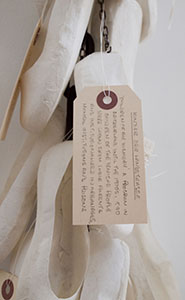
The ideas and the way in which I want to present those ideas. They don’t appear in a vacuum. I do a lot of reading, newspapers, magazines, books etc. and NPR is on the radio in the background most of the day. Even wandering around junk shops and surplus stores I see an item which will spark any idea which I investigate and work from there. I once found a huge box of beautiful large bonsai scissors. I bought as many as I could carry. l was on Canal Street at the time with no transport. The work was called ‘Cutting Ties’ and it was the fastest piece of work from idea to completion, probably about two weeks.
What was your inspiration for creating the ‘Inner Sanctum’ series, do you see your work that is very woman related as being feminist.
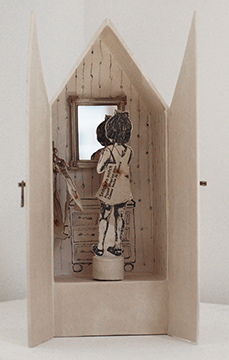
I have never really thought of myself as feminist, although my work has been included in some exhibitions that have addressed that subject. Inner Sanctum, more than most of my other work addresses that. I was concerned that today young girls were coming of age in an American culture that valued dress, beauty and popularity above all else, although now this can be applied to the boys as well.
Are today’s current events playing a role in your works?
My recent piece ‘Stolen’ was prompted by the abduction of the girls by Boko Haram in Nigeria but as I worked through my research I saw how many civilized western countries in the 19th and 20th centuries had written laws to enable them to remove children from their parents to give them a ‘better life’. A few did get a better life but very many did not.
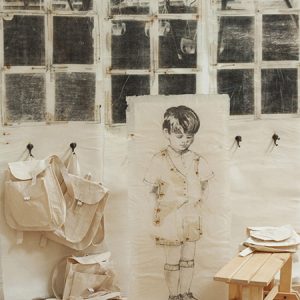
What issues are addressed in your works that you find relevant today?
All the issues I address in my work are relevant today, although the work has an old fashioned look to it. Two pieces of work, one in 1999 and another in 2014 addressed school shootings,Columbine and Sandy Hook respectively. My current houses are in response to how the Internet allows predators into the home to stalk our children along with the bullying from other children.
What medium do you find the most difficult to work with?
I am a mixed media artist so I work with all different media but not an expert in any. If I require information about a process I use the Internet. I also take classes if they will be useful to me in the future. Working with metal and welding is not really difficult but I use oxyacetylene and am always super safety conscious. I require metal supports for my paper sculptures. I have a wood shop and have the same respect for all the large electric saws I use.
Are you working on any projects now?
I am always working on a few projects at a time. Pieces take a long time to complete. I design them, make the paper I require and work from there. Usually I have a series of works whose construction I am finishing, another where I am making paper and drawings and another working on the idea and the research. Recently I have finished a series of row houses but the majority of my time has been spent constructing children’s shoes out of paper and the research for another piece
When do you consider your work finished?
The installations are never finished, usually made for a specific space but as they are exhibited in different places I either subtract or add pieces. Older installations over time may get totally reabsorbed into newer ones, so totally disappear, all I have left is the photographs. The sculpture houses have a definite finish point when you close the last wall. I work from the inside out and they have to have structural integrity. I can’t keep taking them apart, the paper would be too damaged. Consequently I have a few I don’t exhibit.
What is your dream project?
I don’t know that I have a dream project although an installation in a major museum would be any artists dream project. I suppose my dream is to have enough time to get to all the projects for which l have ideas. My time is very full and as I said before I have learnt to make time for my work, I try to treat it as a 9-5 job which is not always possible. I have six wonderful grandchildren who live close who I love to see and am the emergency baby sitter and an elderly father in the UK who I try to visit every three months. I still manage to make art, not as much as I want to but often the downtime focuses my ideas.
click here to see more of Pam Cooper’s work
